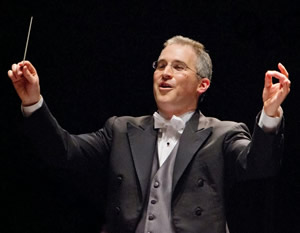Rodney Wynkoop must be sick unto death of hearing us complain about distracting and unwanted reverberation in Duke Chapel. While the Chapel sports no stone statues, phantom gargoyles usually play handball with the sound. And it’s true that this neo-gothic behemoth works best for music of the sixteenth century and before. Nevertheless, the gargoyles must have taken a holiday Friday evening for the Choral Society of Durham and the North Carolina Symphony in a program with the all-too-appropriate theme of war. To our great surprise, everything worked in this normally hostile environment: the music, the musicianship and the balance of forces large and small.
The program featured two works, Franz Joseph Haydn’s Missa in tempore belli (Mass in Time of War) – or Paukenmesse (Timpani Mass) as it’s called in German – and Ralph Vaughan Williams’s Dona nobis pacem (Grant Us Peace). Although we seldom see the intrusion of politics or current events into the classical music scene around here, there’s no doubt that there was no coincidence between the subject matter of this program and the circumstances in which our country – and indeed the world – finds itself. Maybe the phantom gargoyles understood how important it was that this cry for peace be as clear and articulate as possible.
Composed in 1796, the Missa in tempore belli was a response to the threat of Napoleon, who had taken northern Italy by storm and was on the brink of attacking Vienna, the heart of the Hapsburg Empire. Haydn’s Mass, however, reflects both the threat of war and the general optimism that pervades so much of his music. Although the predominance of the timpani conjures the image of artillery, the unusually long Dona nobis pacem that concludes the Mass is almost dance-like.
The forces of the NCS and Choral Society of Durham far exceed anything Haydn would have had at his disposal, except perhaps for The Creation, but everything came together exceptionally well. Neither the chorus nor the orchestra drowned out the quartet of soloists: soprano Elizabeth Williams-Grayson, mezzo-soprano Mary Gayle Greene, tenor Stephen Cary and baritone Gerard Sundberg. Sundberg’s aria “Qui tollis peccata mundi” with solo cello accompaniment by Bonnie Thron was one of the highlights of the evening. Williams-Grayson’s liquid voice was occasionally shrill in the highest register, but she more than redeemed herself in the Vaughan Williams. The chorus was exceptionally well balanced and smooth.
Vaughan Williams’s Dona nobis pacem is quite another kettle of fish. Composed in 1936, at a time when Europe was threatened by Adolf Hitler rather than Napoleon, it is the musical equivalent of the poetry of Wilfred Owen, although the text comes mostly from Walt Whitman. It is music of such power and despair that it could only have been written after the senseless brutality and carnage of World War I. The anguish at the gathering clouds of another war is palpable, and the call “Dona nobis pacem” which is repeated by the soprano four times in the course of the work, becoming more desperate – and weaker – with each cry. In between these repeats Vaughan Williams introduced the poetry of Walt Whitman, starting with the grim and powerful “Beat! Beat! Drums!” which the chorus, with the percussive accompaniment of the orchestra, gave a chilling performance. Sundberg followed with an exceptionally sensitive singing of Whitman’s most moving words “For my enemy is dead, a man divine as myself is dead!”
The “Dirge for two veterans” is probably Whitman’s most moving and desperate condemnation of war. A witness to the carnage of the Civil War, his lines all too aptly fitted W.W.I as well. Vaughan Williams’s emotions at the inevitability of another war is palpable in the music, and Wynkoop got the chorus and orchestra to convincingly project the sense of disillusionment and terror.
Sundberg gave another powerful interpretation of the excerpt from John Bright’s famous speech (“The Angel of Death has been throughout the land”) to the House of Commons during the Crimean war, which opens the final movement. His voice was well-balanced with the chorus and the diction clear.
The work ends with a setting of various Biblical verses exclaiming a prayer for peace and brotherhood, introducing a ray of optimism and hope; but the movement ends with the final plea “Dona nobis pacem,” movingly sung by Williams-Grayson – morendo.











